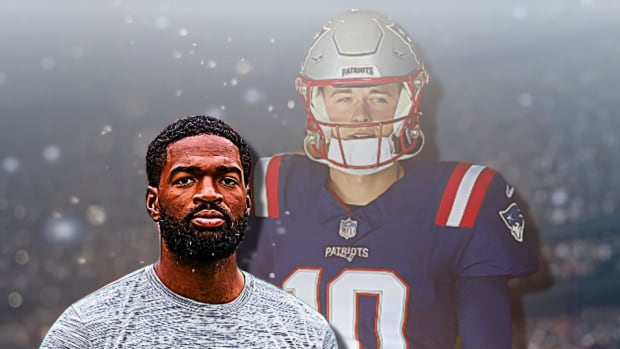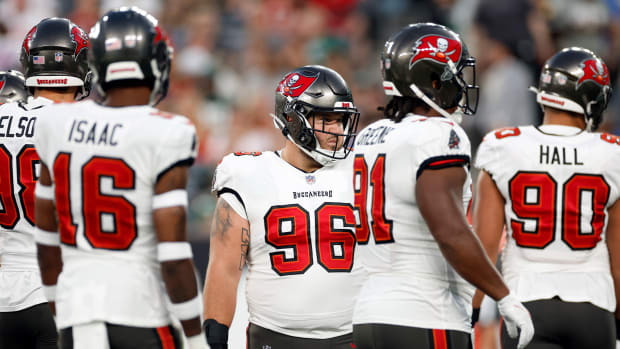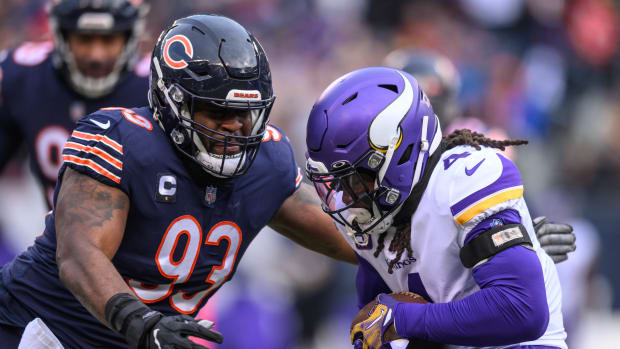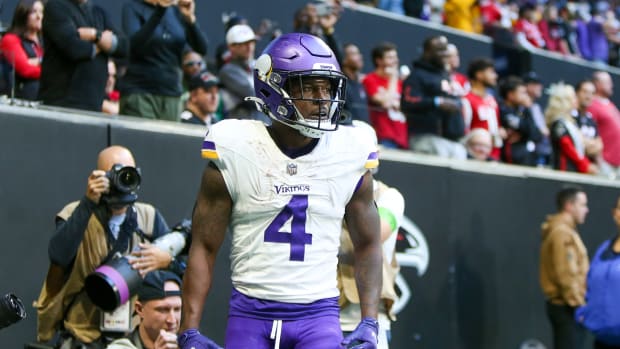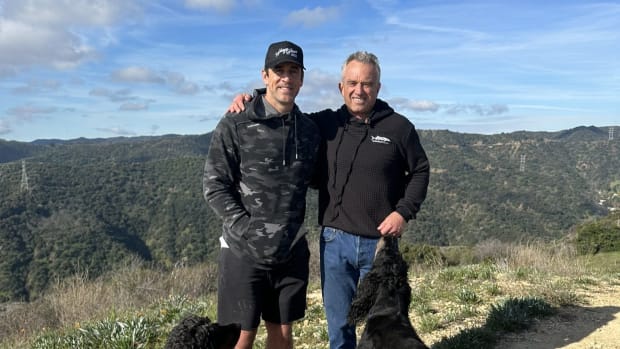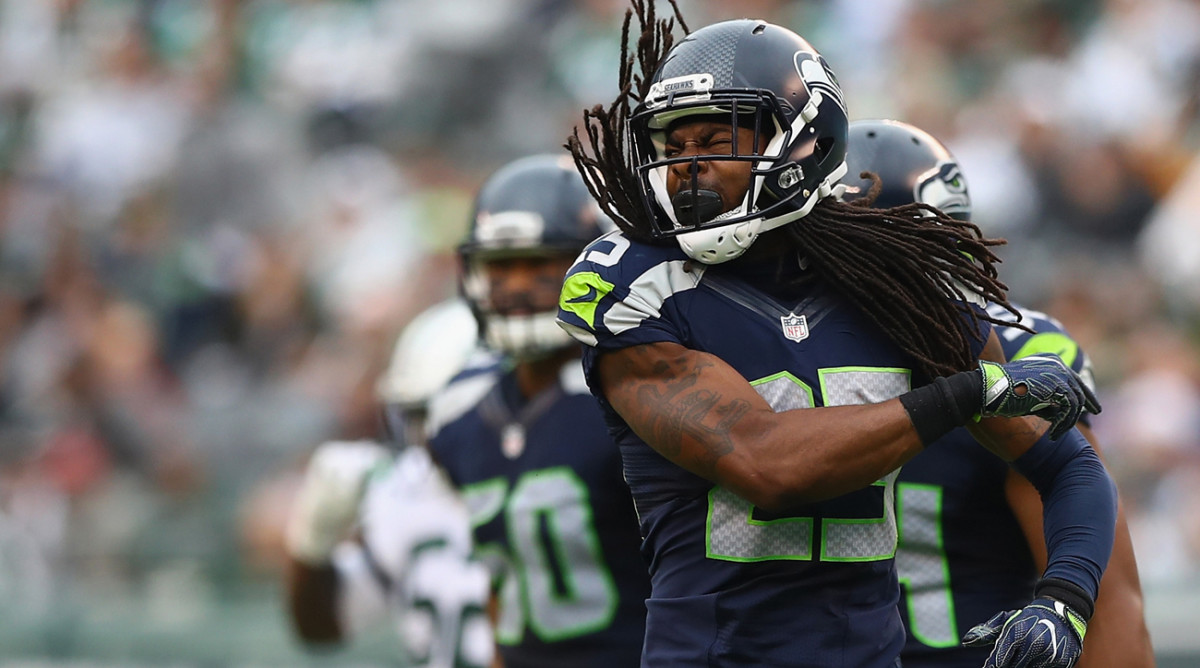
Richard Sherman Is Not Apologizing
RENTON, Wash. — Richard Sherman had the carpets made a few weeks after Super Bowl XLVIII, the 43-8 torching of the Denver Broncos on Feb. 2, 2014 in New Jersey. They’re the size and shape of doormats, navy and gray and neon green, with the words “Legion of Boom” stitched below a Seahawks logo, and the jersey numbers of every defensive back on that 2013 championship team riding the border.
That was less than two years ago. Today six out of the 12 names on the carpet are on new teams or retired, including onetime Seattle starters Byron Maxwell and Brandon Browner. Of the three core members of the Legion of Boom—Sherman and safeties Earl Thomas and Kam Chancellor—only Sherman started every game in 2016, a 10-5-1 season that continues in the playoffs this Saturday against the Lions, and possibly beyond, with (likely) two road games between the Seahawks and Super Bowl 51 in Houston. Thomas and Sherman have been the only players to bring their carpets on the road, dressing in unfamiliar locker rooms with familiar stitching under their feet.
And now that Thomas is out with a broken leg, only Sherman keeps up the tradition. He likes to say, “Every game’s a home game.”
Normalcy, for Sherman and these Seahawks, is a fleeting thing. They began the 2016 season with the seventh-youngest team in the NFL, with an average age of 25.6. Seattle still boasts one of the best defenses in the NFL, ranking third in points allowed and fifth in yards, but cracks have shown in Thomas’s and Chancellor’s combined nine games missed, and Sherman has amplified the ruptures with several visible tirades.
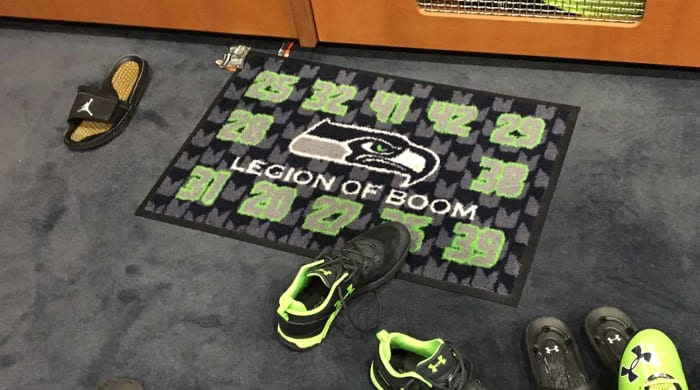
The Legion of Boom carpet accompanies Sherman on the road, but many of its original members have moved on.
Robert Klemko/The MMQB
During one game, a breakdown in communication devolved into a shouting match between Sherman and his defensive coordinator. Sherman has decried the conservative defensive play-calling in the waning moments of a win, and two weeks ago he found himself shouting at his offensive coordinator and head coach over a near-interception at the goal line that brought back memories of the Super Bowl loss to New England following the 2014 season. Sherman is the team leader who appears, at least from the outside, to be at odds with the men calling the shots.
“I’m not just going crazy,” Sherman says, leaning back in chair inside the team lounge while watching his alma mater Stanford’s bowl game last week. “Sometimes I get frustrated, and from time to time it’s a spur of the moment thing, but a majority of the time it’s calculated. I’m doing this to make a bigger point.
“There’s gonna be a light at the end of this tunnel.”
* * *
David Shaw describes Richard Sherman, 28, in honest terms that just about everyone who knows him agrees with, including Sherman himself.
“There are two Richard Shermans,” Stanford’s head coach said on “The MMQB Podcast with Peter King” in December. “There is the Stanford Richard Sherman, who is brilliant. Not just smart; he is brilliant. Thoughtful, intelligent, intellectual, conversational on a variety of topics. And then there is the Compton Richard Sherman, who is ready, willing and able to fight anybody at any battlefield at any time. They are embodied in one person. At different times, we get different ones.”
“Sounds about right,” Sherman says.
The Compton side of Sherman threatens to ruin a reporter’s career by having his credential revoked, while the Stanford side explains his recent tensions with the local Seattle media in erudite terms: “I think nowadays it’s getting increasingly difficult to deal with media outlets because it’s about getting clicks. It’s not their fault; it’s their job. Their editor is saying ‘Do whatever you have to do to get clicks.’ You can slander people, misquote people, and there’s no policing it. Instead, I can direct all the traffic to social media or my own website, and get the truth out.”
The Stanford side of Richard Sherman says he wants to have Seahawks owner Paul Allen’s job when he’s 40. Sherman has equity in The Players Tribune and in Body Armor sports drinks, with a chain of Wingstop franchises in the works and an eye on other business opportunities. The Compton side of Sherman knows where he’s sending his infant son to play AAU basketball when the time comes: “Tacoma, where he’ll have to earn everything, not Bellevue with the other rich kids.”
“If I’ve burned bridges,” Sherman says, “they’re not in this building.”
The Stanford side of Sherman has built a network of socially and financially conscious NFL players with whom he talks politics and preps for the coming collective bargaining negotiations in 2021. He trades jerseys with them after games, and has the shirts framed on his wall at home. The Compton side knocks those same players senseless the moment the quarterback rolls out of the pocket and it becomes legal, if uncouth, to do so.
When he was a teenager, it was more difficult to control the Compton side, Sherman says, which is why everybody who played with or coached him at Stanford has a story about Sherman wigging out. “I think it was in his first year there,” says Clayton White, former Cardinal defensive backs coach and currently the defensive coordinator at Western Kentucky. “Sherman was playing wide receiver then, and one day during a one-on-one blocking drill with the receivers and DBs somebody said something to him, and he just started yelling at all the DBs and me.”
Y’all can’t mess with me! Y’all can’t mess with me!
“I liked that dog in him a little bit,” White says. “I wanted him on my side.”
A year later Jim Harbaugh took over at Stanford, and Shaw was hired as offensive coordinator. The Cardinal were sitting at 3-5 before a home game against Washington in 2007, with injuries having decimated the backfield. Frustrated with the direction of the offense, Sherman began calling for the football on the sideline.
“Throw me the ball!”
Senior receiver Evan Moore remembers shooting Sherman a look and saying, “Let’s relax.”
Liftoff.
“When that anger sets in about the way things are going, he can fly off,” says Moore, who went on to play tight end for four NFL teams, including in 2012 with the Seahawks, and now works as an analyst for the Pac-12 Network. “We went toe-to-toe and we were separated by the coaches.
“It’s honestly his biggest asset—the emotional way he approaches the game. As long as you control that, it’s an asset. He’s not head and shoulders above every corner in the league as an athlete, he’s just so smart, so emotionally invested.”
Stanford lost the game that day, 27-9 with Sherman finishing with two catches for 11 yards. He was suspended indefinitely for “poor sportsmanship on the sidelines,” according to Harbaugh. Sherman remembers it differently. “This is a game we should’ve won,” he says, his voice rising as if it were yesterday. “We converted a corner to running back, and all we’re doing is running the football. I’m sitting here having one of the best seasons in recent memory, and I can’t get a few targets? Are we trying to win?
“If we run the ball 100 times, and we win, s---, don’t give me the ball. Whatever’s best. But if we’re running the ball, we’re getting killed, we gotta try something else.”
It’s with that same motivation that Sherman targeted coach Pete Carroll and offensive coordinator Darrell Bevell two weeks ago during a win over the Rams that made headlines for the wrong reasons. At the L.A. 1-yard-line, up 10-3, the Seahawks coaches called for a pass on first down. The throw went incomplete to Jimmy Graham but looked for a moment as if it had been intercepted, a copycat scenario (albeit with much lower stakes) to the Super Bowl finish in which Malcolm Butler of the Patriots picked off Russell Wilson at the goal line for the win.
Sherman later explained that Bevell “came up to me,” after the cornerback was voicing his displeasure to Carroll. “So we’re not going to have that,” Sherman said. On another team, with another cast of characters, it was a scene that might have ripped apart a locker room. Instead there was only hand-wringing among a management group that had inked Sherman to a four-year contract with $40 million guaranteed in May 2014. Bevell, Carroll and the rest of the locker room largely played it off, even after Sherman doubled down on his criticism the following week. “That’s something you have to earn,” says safety Jeron Johnson. “Is it right? Is it wrong? I’m not the one to say. But that’s something you have to earn the right to do.”
“If I’ve burned bridges,” Sherman says, “they’re not in this building.”
It wasn’t the first time this season Sherman jawed with a coach. Back in October in a game against the Falcons, Seattle gave up an easy Julio Jones touchdown later chalked up to a miscommunication between Sherman and reserve safety Kelcie McCray. Sherman and defensive coordinator Kris Richard exchanged words on the sideline after Sherman felt he was being blamed for the miscommunication.
"He’s always communicated with us, maybe not in a blowup fashion, but humans get frustrated,” Kris Richard says three months later. “That’s our responsibility, to make sure we reel him back in.
"As a group we need to bring the guys along as fast as possible. We want to eliminate the learning curve, and it hasn’t essentially worked out the way we want because we’re in the pursuit of perfection. We’re going to take our lumps and get guys experience, and that’s a process.”
It was an episode symptomatic of a roster accustomed to success and facing the inevitable lapses that come with personnel turnover and injury. In their heyday, the combination of Sherman, Thomas, Chancellor, Browner, Maxwell and Lane could simply evaluate a situation and understand what coverage they ought to be in, sometimes without even exchanging words or gestures. That era is over.
“We overcommunicated from then on out,” McCray says of the Atlanta foul-up. “Even the smallest things, we made sure. A lot of times we take the smallest things for granted, thinking certain people know stuff. We had to get back to the fundamentals. Not saying I was right or he was right ... Sherm and I were on separate pages.”
Communication became a priority for the secondary, but its production still lagged in the sporadic absences of Chancellor and Thomas. In the nine games without one of Thomas or Chancellor, opponents completed 64.1% of their passes and averaged 262.5 yards through the air, with 12 touchdowns and three interceptions as Seattle went 4-4-1. In the seven games in which both Thomas and Chancellor started, opposing quarterbacks completed 58.2% of passes for an average 217.2 with four touchdowns and eight picks. The high expectations for reserve players that accompanied Super Bowl runs of years past have run into the reality that Thomas and Chancellor are practically irreplaceable. One of Sherman’s closest friends believes that realization can help explain Sherman’s volatility in 2016, though Sherman says he’s no more fired up than usual.
Doug Baldwin, Seattle’s leading receiver, was there with Sherman for the beginning at Stanford, then through the transition to cornerback and Sherman’s rise to stardom in the NFL. “I think there’s frustration with the lack of production with those guys who have replaced Earl and Kam,” says Baldwin. “There’s such a high standard that when it’s not met, it’s frustrating. I’m sure he’ll get mad at me for saying this, but it’s a maturity issue on his part too. He’s got to be that helping hand for those guys that aren’t normally back there.”
* * *
When McCray, the strong safety, arrived in Seattle via trade with the Chiefs last September, Sherman was one of the first players to reach out to the fourth-year player out of Arkansas State. “He invited me over for Thanksgiving,” McCray recalls. “But my girlfriend was tired and didn’t want to go out, so I didn’t go, and he gives me stuff about it every year.”
Sherman wouldn’t relent. Later on that winter he approached McCray after practice and told him his wife had dropped him off at the facility that morning and he needed a ride 30 minutes southeast to his home in Maple Valley. “So I went in and saw the mansion, and before I left he gave me a bunch of shoes. Four or five pairs of size 13.”
“I’ve been on other teams where the superstars act like they’re better than you,” says McCray, a veteran of the Dolphins, Buccaneers and K.C. “But Sherman is not like that. He’s a down-to-earth guy.”
• THE OFF-SEASON TO-DO LIST: Andrew Brandt on the key issues facing each NFC team
When Sherman was a rookie in 2011, the fifth-round pick would eat lunch with sixth-year pro Brandon Browner, who had just returned to the NFL after a four-season spell with the CFL’s Calgary Stampeders. As Sherman aged and found success in the NFL, and players like Browner moved on, Sherman became the elder statesman. Now he holds court in the cafeteria with a handful of young players including rookies Tanner McEvoy and Trevone Boykin.
“When Brandon and Richard were together, that was certainly a case of iron sharpening iron,” says Kris Richard. “Brandon was able to impress upon Richard this sense of not allowing this opportunity to pass you by.”
Teammates say Sherman has made extra effort over the past two seasons to reach out to the entire roster, including those on the mend. In the weeks and months after tight end Jimmy Graham suffered a ruptured patellar tendon in a Nov. 29, 2015, game against the Steelers, Graham could count on Sherman to find him in the locker room every day during his rehab.
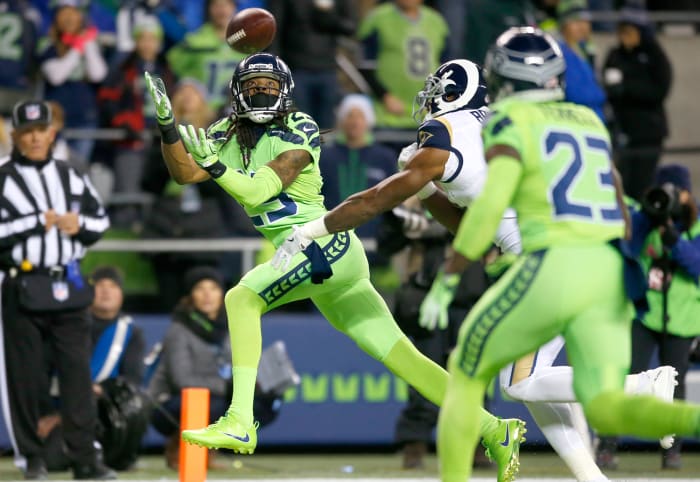
Seattle’s pass defense is still among the league’s stingiest, but there have been issues as younger players are worked into the secondary alongside vets like Sherman.
Otto Greule Jr/Getty Images
“Honestly he was a big part of my recovery,” Graham says. “Every day he would come in, scream my name and give me a hug, and tell me how they need me to win, and how great I’m going to be and how strong I’m going to come back. Literally every day. So that’s a special person.
“Someone who speaks their mind all the time, people are critical of you and everything you do. You put a target on your back, and he steps up to that challenge every single day with the way he treats people, with the way he practices and plays on Sundays.”
It’s fair to wonder how much tolerance any locker room or coaching staff would have for such an outspoken player if he wasn’t described by coaches and fellow players as a tireless worker and consummate teammate and wasn’t one of the top players at his position. Said one NFL GM, asked if he’d sign Sherman to a free agent contract today: “He’s still a tremendous player, but we’d have to be just a couple pieces away, with a coaching staff who was comfortable dealing with him. And even then...”
Sherman’s 2016 season is the fifth in a row in which he’s started all 16 games. He finished this year first in snaps per completion against him (one completion per 14.9 snaps) and quarterbacks had a 63.8 passer rating when throwing at him. His 30 interceptions since 2011 are 10 better than the next-closest cornerback, Arizona’s Patrick Peterson.
“Wanting to win is my justification for everything. All I can do is be myself.”
Sherman’s evolution from an injury-plagued college receiver to perhaps the most durable and prolific cornerback of this decade can be traced to one decisive clash with Harbaugh, which prompted the offensive-minded coach to grant his third-year receiver’s request to play defense, where he felt he could impact more plays without the reliance on a quarterback getting him the ball.
“Jim [Harbaugh] and Richard had a little falling out,” says former Stanford co-defensive coordinator and assistant head coach Ron Lynn, who helped Sherman make the transition in 2008. “I know when he was playing receiver he thought he was open all the time and wasn’t afraid to voice that. And Jim was not a flamboyant personality guy."
During the first practices after the switch, Sherman resolved to needle Harbaugh by calling out the offensive play call when he recognized what the other side was about to run based on his knowledge of the offense. Harbaugh called a private meeting with the new cornerback who was moving up the depth chart.
“He asked me to stop,” Sherman says, “and I politely said no. I was going to ruin everything. I was gonna do him like he did me. On offense he gets to call all the shots. But on defense they’re not really giving him a lot of rein on that side. The depth chart was objective. Whoever is playing best, plays, and I can live with that.”
Lynn sees the clashes with coaches broadcast on television and thinks back to those early clashes with Harbaugh. Unlike today’s Seattle team, Stanford was losing then, yet to achieve the perennial success under Harbaugh and later Shaw.
“I think the more powerful the players get in the game, the more it takes place, often not on camera like you’ve seen in Seattle,” says Lynn, who coached in the NFL from 1986 to 2003. “You don’t mind it if it’s a thoughtful guy who works like crazy and studies the game. You’ll have those discussions if the guy is totally invested in the success of the team. And Richard is much more invested in the success of the Seahawks than he is in the success of Richard Sherman.”
* * *
Every year, it seems, the Seahawks hold what Sherman describes as a “kumbaya meeting,” an impromptu team session meant to re-energize and hammer home team goals after a bout of turmoil. In 2014 the meeting came following the midseason trade of wide receiver Percy Harvin, who had come to blows with teammate Golden Tate during Super Bowl week and with Doug Baldwin that August.
This year the unplanned team session came in the days after the victory over the Rams, during which Sherman unearthed the two-year-old sore that is Seattle’s decision to throw at the one rather than hand it off to Marshawn Lynch in the Super Bowl. Bevell said he’d met with Sherman that week after the Rams win but declined to discuss specifics, only to say that he saw no value in reasoning with Sherman over the validity of throwing at the one-yard line. (For the record, by Week 15, the Seahawks had had the ball eight times in 2016 at the opponents’ two-yard line or closer and thrown twice, both for touchdowns, and run the ball six times for three scores.)
• 2017 MOCK DRAFT: Emily Kaplan’s first mock of the year has some surprises in store
Sherman still rejects the notion that the Seahawks should throw in such situations, despite what statistics say about the low-risk, high-reward nature of the play-call. (Wilson’s ill-fated toss in the Super Bowl was the first time a throw from the one was intercepted all season). I asked Sherman if he’d be okay with Doug Baldwin lashing out at Kris Richard if the tables were flipped. “If we had lost in an all-out blitz on a fade [in the Super Bowl], and we ran an all-out blitz for the game, and they almost score a touchdown on a fade, then yes,” Sherman says. “Because it’d be like what are we doing? Are we really gonna do this again?”
ICarroll, who said the Rams sideline incident was part of the reason for the meeting, also had a one-on-one with Sherman that Monday to discuss it. Sherman left believing his relationship with the head coach who drafted him into the league had not soured. “Our conversations, they’re pretty wide ranging,” Sherman says. “We talk about the game, we talk about the future, we talk about the past, we talk about his goals, his ambitions, mine, my ambitions. He’s the kind of person who cares about more than just the X’s and O’s of a football player.”
As for the team meeting, Baldwin left wondering if the message had stuck with the under-25 crowd in the locker room. Seattle ended up dropping the following game 34-31 to Arizona before wrapping up the regular season with a win at San Francisco.
“It was a time when we really needed it,” Baldwin says, “but I don’t know if the younger guys truly understood the gravity of that conversation. We have a lot of young guys still trying to find their way, so I think it was a good conversation but I don’t know if everybody understands.”
Carroll, his staff and his veterans are about to find out very quickly if the urgency of the moment has resonated with its young roster. A win over Detroit would mean a divisional-round visit to Atlanta, which boasts football’s No. 1 passing offense, with Matt Ryan and Julio Jones each at the top of their game, and offensive coordinator Kyle Shanahan being touted as the top head coaching candidate for 2017.
• COACHING VACANCIES AND HOW TO FILL THEM: Andy Benoit analyzes the openings and offers his best fit
A look further down the road shows the Patriots with a near clear-cut path to the Super Bowl, with Tom Brady leading Bill Belichick’s team to the top seed in the conference without so much as a hint of controversy following the completion of Brady’s four-game suspension. If Belichick’s team is an ocean liner steaming in a straight and uncompromising line with militaristic discipline towards Houston, Carroll’s is a pirate ship, bounding up and over choppy waters, with democratic upheavals in its past and future, and daunting obstacles ahead.
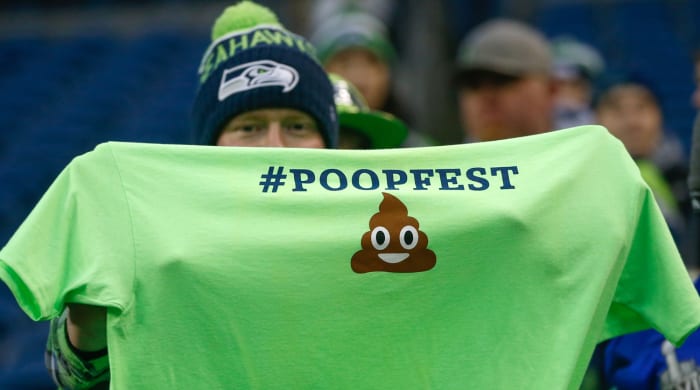
Fans embraced Sherman’s colorful description of Thursday night games, which he’s never liked.
Otto Greule Jr/Getty Images
It’s the kind of environment Sherman has thrived in, from his unlikely escape from Compton to his unforeseen opportunity to play cornerback in the NFL. Sherman’s internal fight and the balance he appears to have struck mirrors what the Seahawks are going through: grappling with their own contradictions and seeking that middle ground between passion and poise, between Compton and Stanford.
For Sherman there’s only one acceptable result. “Winning. Just winning,” he says. “Wanting to win is my justification for everything. When everybody wants to win as bad as everybody else, then what I do and say isn’t a big deal, because all everybody wants to do is whatever it takes to get a win. There’s not this shallow back-and-forth.
“Certain people see me as a villain, and they’re never gonna be convinced otherwise, and there are certain people who see me as the hero who would never be convinced otherwise. All I can do is be myself. My imperfections are sometimes out in the open for everybody to see, and that’s fine. I just want to win. I don’t care about the rest.”
Question or comment? Email us at talkback@themmqb.com



































